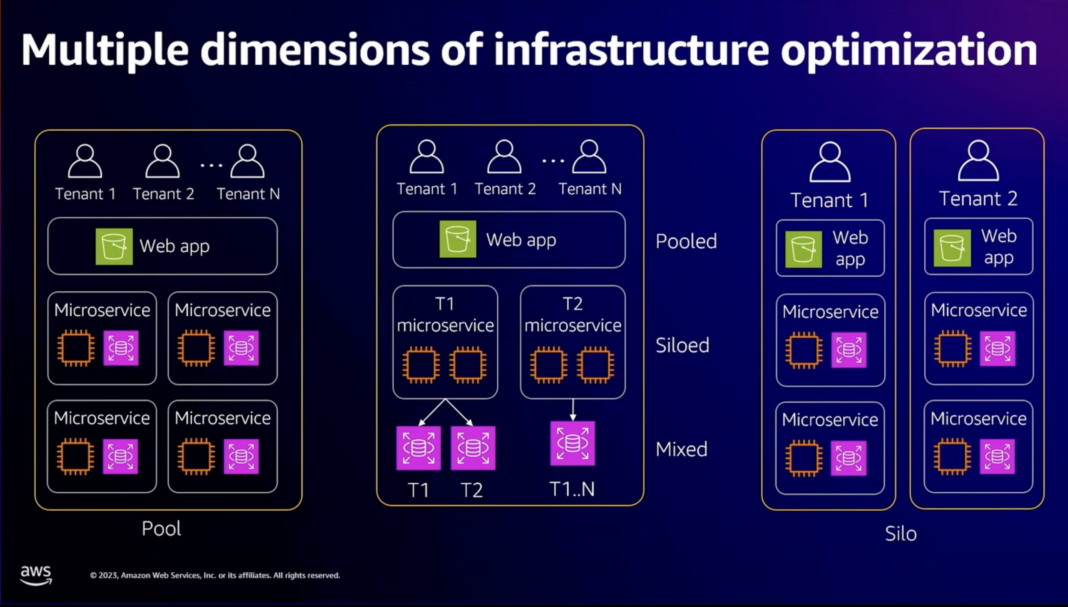Software as a Service (SaaS) applications offer a transformative solution for businesses worldwide, delivering on-demand software solutions to a global audience. However, building a successful SaaS platform demands on meticulous architectural planning, especially given the inherent challenges of multi-tenancy. It’s also essential to ensure that each tenant’s data remains isolated and protected from unauthorized access and that multi-tenant systems are cost-optimized and can sustain the scaling of the SaaS business provider.
In this blog post, we will explore some of the key elements and best practices for designing and deploying secure and efficient SaaS systems on AWS.
Building cost-optimized multi-tenant SaaS architectures
Cost is a key factor to consider when we design new systems. Multi-tenancy requires teams to think beyond the basics of auto scaling, adopting strategies to allow their architecture to support a complex cost-scaling challenges. In this session, the speaker covers some design patterns for distributed systems to support the continually evolving scale needs of the environment, while optimizing the cost of the infrastructure.

Figure 1. The architectural model chosen for deploying multi-tenant systems—pooled, siloed, or mixed—significantly influences the cost-optimization strategy. Each approach offers distinct trade-offs in terms of resource allocation, scalability, and cost efficiency.
Take me to this video
Well-Architected SaaS Lens
The SaaS Lens for the AWS Well-Architected Framework empowers customers to assess and enhance their cloud-based architectures, fostering a deeper understanding of the business implications of their design choices. By bringing together technical leadership and diverse teams to discuss strategies for improving various aspects of the system, the AWS Well-Architected Framework facilitates collaborative decision-making. Moreover, the AWS account team can provide valuable support in conducting these assessments, offering expert guidance and insights. The AWS SaaS Lens specifically focuses on how to design, deploy, and architect multi-tenant SaaS application workloads within the AWS Cloud.

Figure 2. The microservices running in a multi-tenant environment must be able to reference and apply tenant context within each service. At the same time, it’s also our goal to limit the degree to which developers need to introduce any tenant awareness into their code.
Take me to this well-architected framework
SaaS anywhere: Designing distributed multi-tenant architectures
Not every SaaS provider has the luxury of running all the moving parts of their solution within their own infrastructure. SaaS teams might support a range of diverse system models, where architectures might include customer-hosted data, edge deployment for parts of the application, and on-premises components. In this session, you can learn the strategies to support the complexities of this distributed model without undermining the resilience, operational efficiency, and agility goals of your solution. The video covers how this influences the onboarding, deployment, and profile management of the SaaS environment.

Figure 3. In this architectural pattern, tenants are demanding to have the ML workload in their environment. So, the SaaS provider only manages the SaaS control plane where tenants deploy the application plane in their environment, including the ML workload and the necessary components around it.
Take me to this video
Deploying multi-tenant SaaS applications on Amazon ECS and AWS Fargate
Containers are frequently employed in multi-tenant SaaS environments to enhance scalability, isolation, and resource efficiency. Developing such systems requires addressing multiple challenges, including tenant isolation, tenant on-boarding, tenant-specific metering, monitoring, and other factors related to multi-tenancy. This session explores how to effectively manage all of these aspects when deploying solutions on AWS Fargate.

Figure 4. Microservices architecture can enhance security isolation by dividing applications into smaller, independent services, reducing the potential impact of a breach.
Take me to this video
AWS Serverless SaaS Workshop
Serverless helps to create multi-tenant architectures thanks to services like AWS Lambda that isolate your business logic per request, making them the perfect companion to run a SaaS platform. This workshop provides a hands-on introduction to creating serverless multi-tenant SaaS applications, helping you get started and gain practical experience.

Figure 5. This is the high-level architecture of the web application you will use in the AWS Serverless SaaS Workshop. In the labs, you will use this web application to add features that are needed to build this final SaaS application.
Take me to this workshop
See you next time!
Thanks for reading! Multi-tenant SaaS architectures require a careful design of your system. In this post, you have discovered key elements for properly designing your next SaaS workloads. In the next blog, we will talk about modern data architectures.
To revisit any of our previous posts or explore the entire series, visit the Let’s Architect! page.
